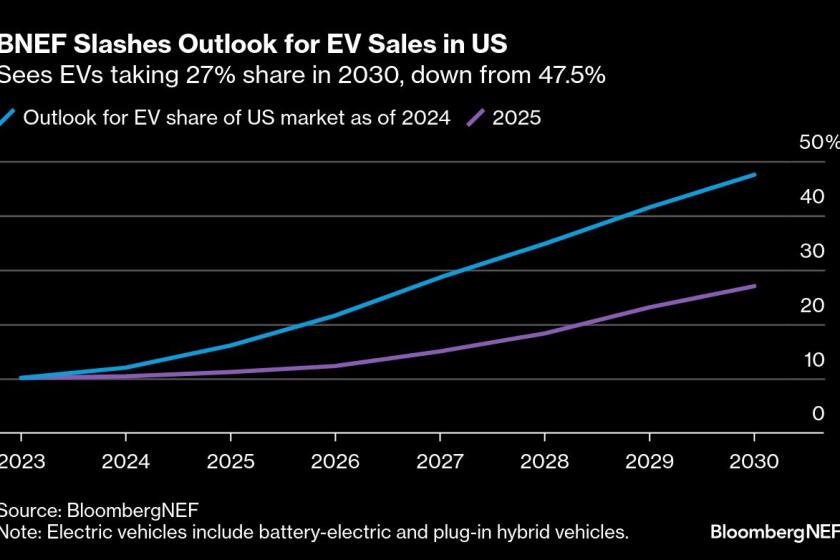Auto Maker Job Boom Seen as Workers Retire
- Share via
DETROIT — After bypassing virtually an entire generation of workers, the U.S. auto industry is gearing up to hire as many as 250,000 new employees in the next several years, according to a study to be released Wednesday by the University of Michigan.
In a glimpse at transformations in store for the nation’s work force as baby boomers turn gray, the study says the hiring is being prompted by a huge “retirement bubble,” an unprecedented exodus of assembly-line workers who entered U.S. auto factories in the booming 1960s.
The retirees, finishing up 30-year careers on the line, are largely traditional blue-collar workers who were hired when the nation’s auto makers--and the manufacturing sector that dominated the economy--emphasized brawn over brains.
Their replacements will be entering an information-based economy that places a premium on technical skills, flexibility and an ability to think and solve problems. Auto firms are already worried about finding the kind of workers they need.
The study says that in the next eight years, about 240,000 workers at General Motors Corp., Ford Motor Co. and Chrysler Corp. are expected to retire. If the Big Three’s market share remains where it is today, they would hire about 213,000 to replace them, reflecting productivity gains.
If Detroit’s new-found competitiveness enables it to gain 5 percentage points of market share from foreign-based auto firms, a scenario some experts find unlikely, the Big Three would need 251,000 new workers, the study estimated.
The figures do not take into account hiring that would be done in the huge auto-supplier industry, consisting of thousands of firms that collectively employ far more than the Big Three. Many old-line supplier firms face a similar retirement bubble in coming years.
“We expect massive hiring in the auto industry over the next few years,” said Douglas Stites, chief operating officer of the Michigan Jobs Commission, which commissioned the study.
The graying of the automotive work force is mirrored in other labor-intensive manufacturing areas and, to a lesser degree, in other sectors of the economy. As the baby boom generation ages, workers are retiring and companies are scrambling to find skilled replacements while getting along with fewer workers.
But the auto industry provides a dramatic illustration of its impact, in part because the Big Three have been slashing jobs for so long. The average age of the industry’s 579,000 hourly and salaried workers is now about 45. A third of the hourly workers already are older than 50 and an equal number has logged more than 25 years on the job.
“It’s magnified in the auto industry because they didn’t hire anyone for nearly 15 years, but it’s a reflection of things to come throughout the economy,” said Diane Swonk, deputy chief economist for First Chicago Bank.
The changes emanating from Detroit will result in one of the largest work force conversions in the 100-year history of the U.S. auto industry. More than 40% of the hourly work force will be replaced by 2003, industry officials estimate.
While overall employment in the domestic auto industry should continue to shrink because of automation and productivity gains, the need for replacement workers will provide job openings that have not existed for more than two decades.
For the Big Three, which have complained that workers at Japanese-owned “transplant” auto factories are younger, healthier and more flexible, the transformation offers an opportunity to fundamentally reshape its work force. By screening workers based on education and technical and teamwork skills, the domestic auto makers hope to make gains against their foreign competitors.
In general, the new assembly line will be manned by workers in their late 20s or early 30s who have at least high school diplomas and are more likely to be women and minorities than in the past.
Under terms of the “30-and-out” provision in the auto workers’ labor agreement, they will collect full retirement pay after 30 years’ service, in many cases at age 50 or younger.
But the changes also present difficulties. Generational clashes over views on factory work rules, privileges and traditions could erupt. Moreover, the auto makers and their suppliers say it is increasingly hard to find workers with the necessary math, reading and computer skills to work in the modern factory.
“There is no longer any room in the auto industry for high school dropouts,” said David Cole, executive director of the university’s Office for the Study of Automotive Transportation, which conducted the study.
The United Auto Workers union, whose role will be critical as the work force evolves, declined to participate in the study and offered little immediate comment on it.
A union spokesman criticized it as a political exercise meant to promote Michigan Gov. John Engler’s economic program more than a meaningful discussion of the manpower needs of the auto industry. The UAW is a vocal critic of Engler, a Republican considered a possible vice presidential candidate this year.
UAW spokesman Frank Joyce noted that the study did not consider the possibility that the Big Three might lose market share or give much notice to the severe downsizing the U.S. auto makers have gone through in recent years.
“This is a political document,” said Joyce. “It bears no resemblance to reality, like the fact this is a cyclical industry engaged in intense international competition.”
Widespread hiring by the Big Three would have an economic impact nationwide, but its deepest impression will be in the Midwest, where the vast majority of plants are located. Half the jobs to be replaced are in Michigan.
Historically, the auto industry has been a major driver of the nation’s economic trends. Early this century, European immigrants and Southern farmers were lured to the industrial Midwest, where they landed well-paying jobs that required little more than a strong back and a willingness to work.
With the end of World War II, the auto industry boomed and factories worked full tilt. The UAW won high wages and benefits, helping to create a blue-collar middle class that could live the American dream--a single-family home, maybe a vacation cottage, boat and second car--and helped to fuel a consumer economy.
Today’s typical Big Three hourly worker makes about $40,000 a year without overtime, and the jobs are highly sought after. The study did not forecast wage trends.
But for many, the good times abruptly halted with the Arab oil embargo and foreign competition. The Japanese stole market share with small fuel-efficient, quality vehicles. The U.S. auto industry was forced to close dozens of factories; the Big Three work force shrank 30% from 1978 to 1992.
For the first time in recent memory, sons and daughters didn’t follow their parents into the factories. As far as the auto industry was concerned, it was a lost generation.
But the auto makers have since downsized, restructured and learned lessons from the Japanese. The changes have made the Big Three profitable competitors again. Ford and Chrysler are already hiring. Most analysts expect GM to continue to shed workers for a few years.
Ford is preparing for an onslaught of hiring as its normal attrition rate of 4% to 5% a year doubles to 8% to 9% in the next three years, due to retirements. The company will have to hire more than 10,000 workers a year to keep its work force at its current level of 105,300.
“What they want is people who can think, problem-solve and trouble-shoot,” said David Jones, chief executive officer of HR Strategies, an employment screening firm for the Big Three.
Of workers hired recently for a third shift at Chrysler’s minivan plant in Windsor, Ontario, 1 in 4 had some level of college education. At Ford, 97% of the hires since 1992 are high school graduates, compared with 86% for its entire work force.
The University of Michigan report says the education system puts too much emphasis on preparing students for college rather than the workplace and that there is a need to change attitudes toward manufacturing jobs.
“We need to remove the stigma of factory jobs,” said Cole. “They are now knowledge jobs that require the ability to think.”






